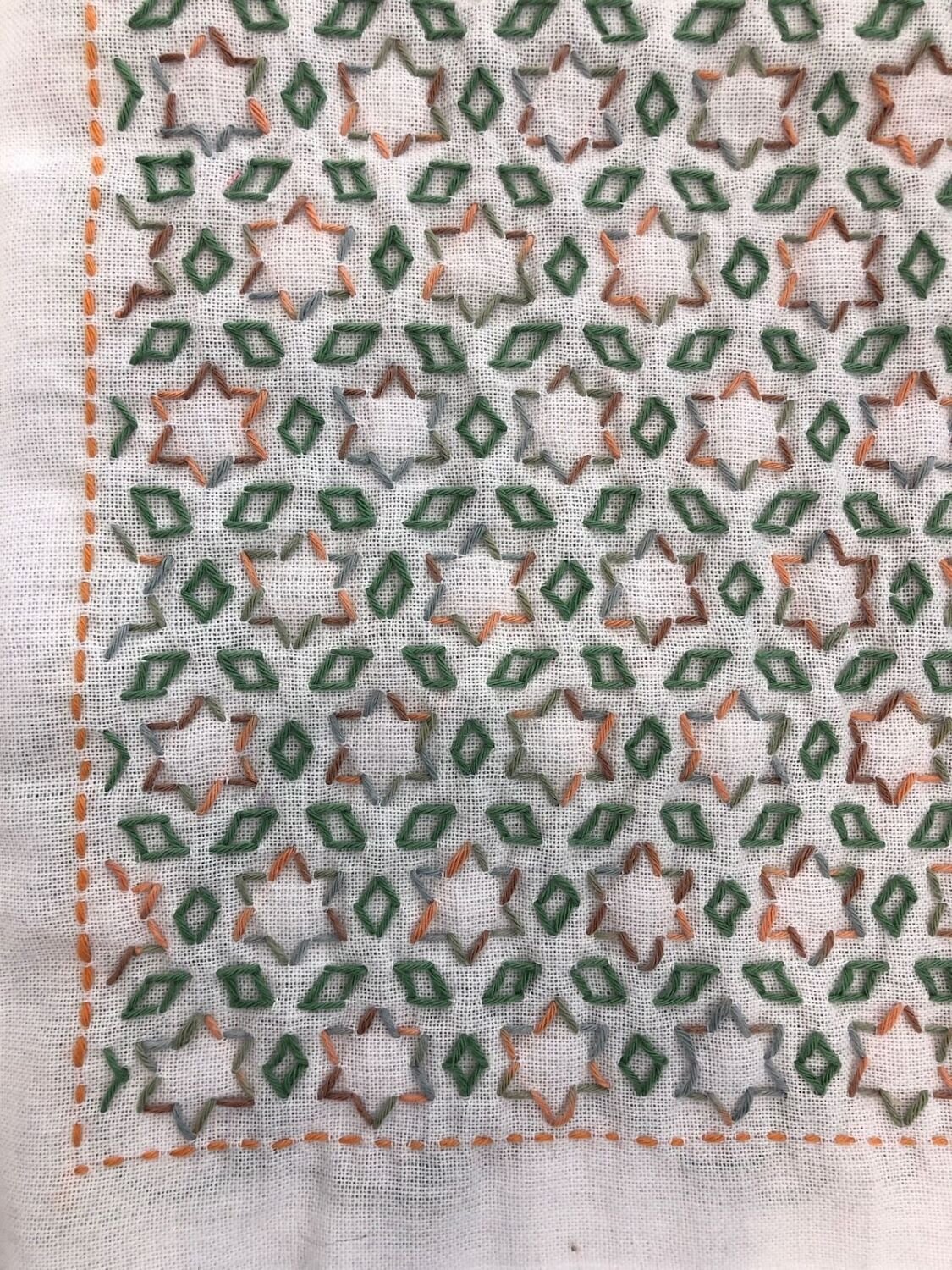Hitomezashi
By Adeline Panamaroff
Adeline, a freelance writer/proofreader, located in Edmonton, Alberta can be contacted at www.adelinepanamaroff.com for writing and marketing requests.
Example of Hitomezashi stitching, worked by Jamie J. The pattern is called Hoshi-to-mitsu-hishi and is from a preprinted panel supplied by Olymus.
History: Hitomezashi, also known as one stitch sashiko, due to the similar length of stitch on both the back and front of the piece, was first widely practiced in the Yamagata Prefecture on mainland Japan. From the 1600s to the 1950s C.E. this stitching technique was used primarily as a means to patch, mend and reinforce peasants’ and labourers’ clothing. During the Edo period, 1603 to 1867 C.E., the working classes were only allowed to wear clothing that was dyed indigo blue, grey or brown. In order to both mend and beautify what they wore, needle workers created visible patterns with their stitches, using light colored threads over a dark background. Using white thread over a dark fabric is thought to look like falling snow over a farm field. Also, the size of stitches that were used was restricted by the ruling class. Peasants were not to use stitches that were larger than a grain of rice. This led to the practice of referring to the stitches that were used being called “plump grains of rice”.
From its utilitarian origins Hitomezashi stitchers developed many intricate patterns that repeated motifs following a grid system that creates a denser design then simple Sashiko which is a closely related embroidery technique. Some important differences between Hitomezashi and simple sashiko is that the later uses curved lines, and allows for more negative space in its design, while the former uses only straight lines and the patterns are much denser. The stitch length for simple sashiko is also much smaller than that of Hitomezashi. With simple Sashiko, the forward-facing stitch is ideally meant to be 2 to 3 times as long as the stitch on the reverse side. When stitching Hitomezashi, the stitch length on the front of the piece is meant to be the same as on the back, creating the same or a different pattern on either side of the piece.
Until the 1970s Hitomezashi was almost a lost art. When historic pieces started to appear in museum exhibits a renewed interest in this embroidery was revived. Women who had worked hitomezashi 20 years earlier started to come forward to offer workshops and classes. Books were written and published, spreading the word about hitomezashi to an international audience.
Technique: Using only the standard running stitch, like other sashiko related stitches, hitomezashi has a more linear feel with its use of straight lines that run on a grid pattern. A grid, of a size determined by the stitcher, is drawn onto a piece of fabric. Then, following a pattern or a design, the embroiderer makes up themselves, sides of the squares on the grid are stitched or left unstitched. The size of the stitches is determined on the size of the grid. It is best to stitch all the lines in one direction first, horizontal, then vertical, then diagonal, using one length of thread for one line. Leaving an unknotted beginning thread and ending thread is best to prevent puckering of the fabric. Having too much tension on the thread is also not ideal.
The motifs in many Hitomezashi patterns tend to mostly be based on nature, though many are just geometric in character. The repetitive patterns can either be one tone or use multiple colors. Thicker cotton threads are used to help the designs stand out and to increase the size of the stitching to look more like plump rice.
Innovation: With the revival that Hitomezashi has enjoyed since the 1970s, this embroidery of humble beginnings now can be seen throughout the textile world. Its utilitarian spirit has not been lost however. It mostly can be seen decorating cloth wraps (Hanafukin), on clothing, wall hangings, tissue box covers, coin purses, place mats or anything else the stitcher can imagine. It even has been seen on high fashion runways as embellishments to trendy textile names. Hitomezashi lives on, strong and robust, in the hearts and hands of stitchers around the globe.
References and Further Reading:
Note: The links above lead to external content. ENG is not responsible for the content of external sites



